12 Italian Potato Dishes You Should Try At Least Once
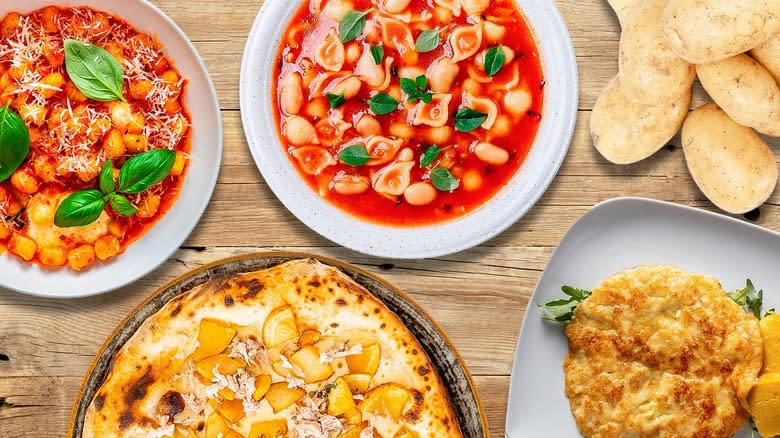
Italy, with its bountiful landscapes and profound history, is a place where food is so much more than just nourishment. It is, and always has been, a way of life, a means of expression, and a vessel to bring people together. This mindset is the reason Italian cuisine has gained the status it has and why it can now be found in nearly every corner of the globe.
Another key reason for Italian food's success is the diverse range of options it offers. Each province of the country has its own idiosyncrasies and iconic eats based on its individual terrain and other influences. In Naples, pizza is king. The Tuscany region takes great pride in dishes which include its famed olive oil and wine. And, coastal cities like those in Sicily live and breathe seafood.
Of course, pasta is prominent no matter where you go. But, there is another less talked about staple food which also seems to pop up in recipes all throughout the country: potatoes. The starchy vegetable is a key part of diets all around the world because of its versatility and sustenance it provides. But, the Italians have a way of incorporating potatoes into meals in the most delicious and innovative ways, taking them to exciting new heights. Get ready to mangia as we explore the top Italian potato dishes that should be on your radar whether you're gearing up for an international voyage or heading to the authentic restaurant down the street.
Read more: Styles Of Regional BBQ In The US
Gnocchi
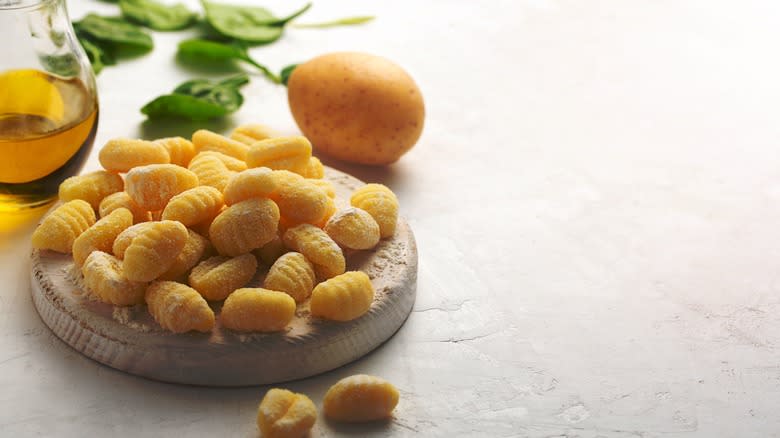
It would be a grave offense to even broach the subject of Italian potato dishes without giving gnocchi a seat at the table. It's one of the pillars of Italy's food landscape, with origins dating back to Roman times. But, interestingly enough, the country's very first versions of the dish didn't even contain potato. Gnocchi's earliest form was called gnocchi alla Romana and consisted of egg and semolina molded into circles. Potatoes didn't take over the dish until closer to the 16th or even 17th century.
Now, gnocchi can be found on Italian restaurant menus worldwide, in a category of its own since it's technically not a member of the pasta family. Potatoes, flour, and egg are typically the three sole ingredients used to create the soft, pillowy dumplings. They can then be topped with nearly any kind of pasta sauce from pomodoro to creamy pesto.
If you're working to master the art of gnocchi making at home it's important to remember a few key tips–one of the most important being that not all potatoes are created equal and how you cook them matters immensely. Yukon Gold potatoes are often your best bet and they should be baked rather than boiled. Additionally, tools like a fine potato ricer and a bench scraper will be your best friend throughout the process.
Gattò Di Patate
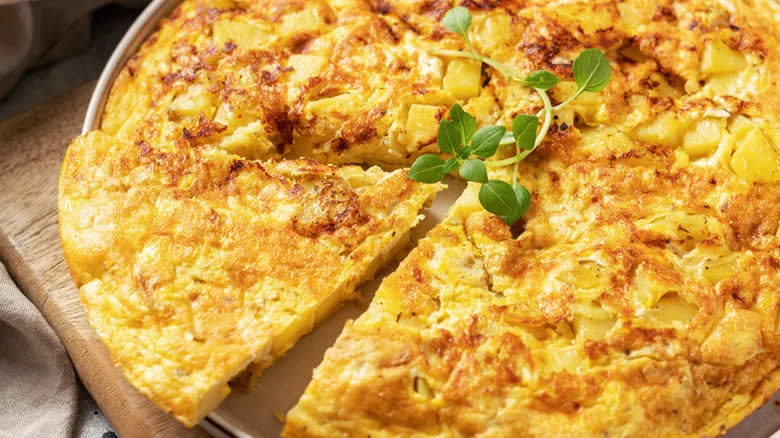
Gattò di patate is the Italian name for a potato pie or cake often served as a savory side dish. The cuisine has ties to France, where it is alternatively referred to as gâteau di patate and where it no doubt acquired its certain je ne sais quoi.
As a fusion of potatoes, egg, butter, and cheese, on paper gattò sounds very similar to what the Germans call kartoffelpuffer, or a potato pancake. But, when you look a little closer, the dishes' stark differences start to emerge. Instead of being fried, gattò is baked, giving it a more fluffy, casserole-like foundation. Gattò is also automatically more complex thanks to the addition of cheese–always locally — Italian, this is a non-negotiable — and also cured meats like salami or prosciutto. These ingredients, in addition to breadcrumbs and basic seasonings like nutmeg and garlic, are then stratified neatly into a deep dish before the baking commences.
Crocchè

If you want to better understand a culture and its culinary influence, street food is a great place to start. Even world-renowned chef Anthony Bourdain loved to explore fare this way. His greatest piece of advice on the subject, which he shared in an interview with Bon Appétit, was to go where the people are and specifically trust the places with long lines of locals.
In the Sicilian region of Italy, one street food you're likely to stumble upon in a crowded square and additionally endure a line for, is crocchè. The dish is what English speakers would refer to as a croquette. It combines creamed mashed potatoes, eggs, and, more often than not, cheese. To take it up a notch, create an elevated version of the snack by pulling flavor from three different types of cheese and additionally throws in a bit of ham. The mixture — whatever it may be — is then pressed into an oval-like shape, coated with breadcrumbs, and deep-fried until golden brown. The end result is reminiscent of a mini corn dog, and is easily taken on the go — perfect for continuing to explore Sicily's picturesque coastline or historic sites.
Patate Al Forno (Roasted Potatoes)
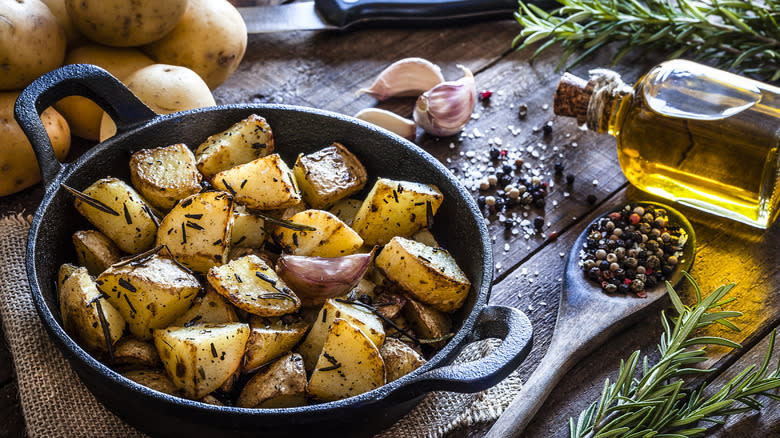
Patate al forno directly translates to English as baked potatoes. But, the Italian name refers to what Americans know to be roasted potatoes — the kind which are sliced or diced before being cooked rather than served whole, skin and all. Roasted potatoes aren't exclusive to Italian culture, but once again, the country brings its own flair to a fairly commonplace dish.
To enjoy your roasted potatoes Italian-style, all you need is your spuds, garlic, salt and pepper, rosemary, and olive oil, applied liberally. In terms of potato cuts, you can opt for either small cubes or thin slices similar to scalloped potatoes. Patate al forno can be done either way, and it really comes down to personal preference.
It sounds simple enough. But, there are a few strict guidelines you'll need to follow if you want to end up with potatoes that are squishy on the inside yet exhibit that quintessential crunchy shell on the outside. Greater importance is placed on using yellow potatoes, which tend to be more starch-filled and dense — not baby reds like you might see in other roasted potato recipes. Yukons are a common choice.
In addition, you'll want to blanch your potatoes. This process involves submerging your potatoes in boiling water for just a couple of minutes and then soaking them in cold water directly afterward. This method removes extra starch to pull off that desired crispy texture.
Italian Potato Salad
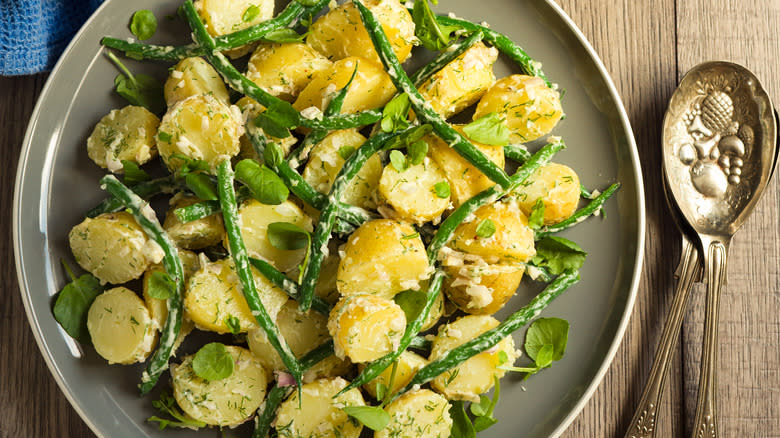
If you order a classic potato salad stateside, a cold mixture of potatoes and eggs smothered in creamy mayonnaise is the food most likely to materialize in front of you. More often than not, mustard will also be thrown in — giving the medley its bright yellow hue — and the only vegetables to note would be small slivers of onion and celery.
In other countries around the world, however, the side dish takes on a whole new appearance and ingredient list. Namely, in an Italian potato salad, you'll find that they take the word "salad" more to heart and additionally swap out mayonnaise for a zappy and refreshing vinaigrette made up of red wine vinegar and olive oil — always of the highest caliber. This dressing soaks into small potatoes, such as fingerlings or baby red potatoes, as well as green beans and tomatoes — which act as counterparts rather than an afterthought. Garlic, parsley, and a sprinkling of Italian seasonings are the final touches.
Boiling the potatoes and combining these elements are essentially the only steps in the preparation process, making this version undoubtedly low maintenance. Plus, just like fine Italian wine, the dish only gets better with time as it sits soaking, just waiting to be devoured.
Pasta E Patate (Potato Pasta)
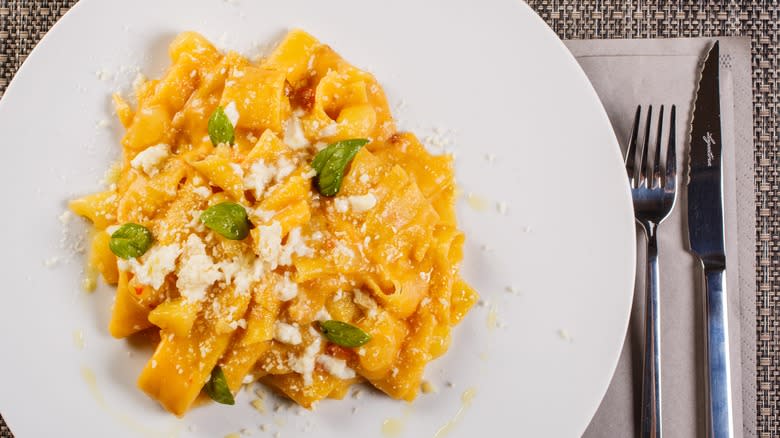
Budget-friendly and simple meals are appreciated in every culture, especially when they can be born from ingredients readily available in your pantry. In Naples, pasta e patate — directly translated as pasta and potatoes — is one such meal.
The dish originated as the epitome of cucina povera, or "poor cuisine." It was often (and still continues to be) made up of leftover pasta of any shape, potatoes, tomatoes, and some variety of fat or olive oil. This idea of double carbs may seem unorthodox, but it is what makes this dish so hearty and filling. The traditional recipe also cooks up easily and is what we would refer to today as a one-pot meal.
Despite pasta e patate's simple and modest roots, it is often elevated in more modern recipe books. Pancetta, onion, celery, Parmesan Reggiano, and Pecorino Romano cheeses are now common add-ins. A Parmesan rind is frequently snuck into the pot as well for even more flavor.
Torta Sabbiosa (Sandy Cake)
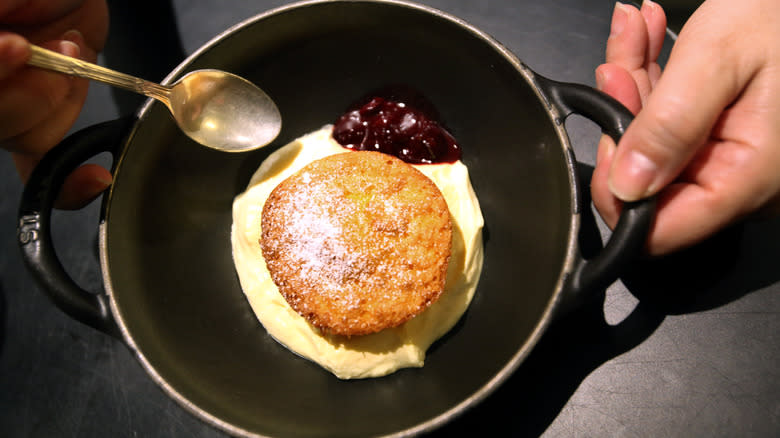
A treat whose name roughly translates to "sandy cake" and which contains potatoes may sound a tad suspect. But don't pass on dessert just yet. As is the case with most foods, northern Italians knew what they were doing when they whipped up torta sabbiosa for the first time. Its soft and delicate nature is now beloved all across the country and beyond.
The dolce starts with a mixture of potato flakes or flour, sugar, eggs, salt, and sometimes additional flour such as wheat or almond. Orange or lemon may also be added for extra zest, and after baking, a sponge cake-like texture reveals itself. The grainy potato flakes are where the dessert gets its name, but also how it achieves most of this desired featheriness.
A powdered sugar dusting is the cake's standard topping. But there are endless ways to dress this confection. Caramel drizzles, mascarpone, velvety cream or icing, and even fruit are just a sampling of the possibilities.
Rafanata (Potato Frittata)
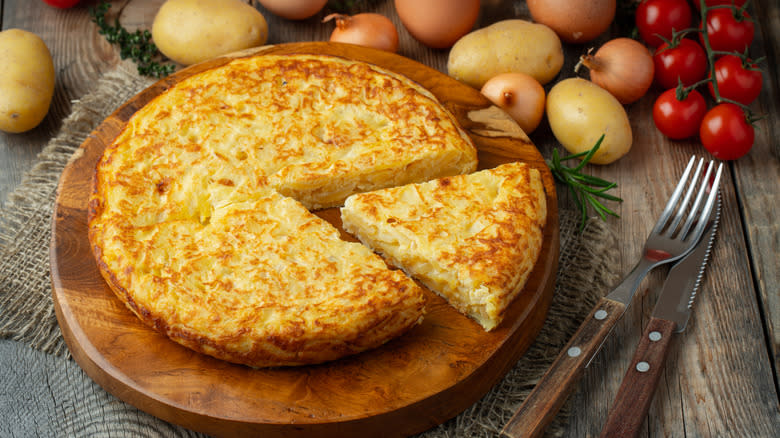
Frittata is one of those foods that sounds a little bit pretentious and unapproachable. But, in reality, it's just a fancy name for an egg-based dish that is cooked with oil on the stove before finishing up in the oven. Its direct Italian translation means "fried," and it falls somewhere between an omelet and a crustless quiche.
There are a myriad of ingredients that can be thrown into a frittata, including the humble potato. This time-honored egg and potato combination is what you'll find at the core of the rafanata — a frittata variety that originated in the southern Basilicata region of Italy. But, this specialized Italian potato frittata additionally throws in horseradish, creating a pungent flavor profile bound to wake you up all your senses in the morning. In rafanata's native region, it's seen as more of a winter dish since that is when the horseradish root is in season.
The process of creating rafanata is quite simple. You will want to fuse together your potatoes — the mashed variety — with your scrambled eggs, freshly grated horseradish, a sprinkling of pecorino cheese, and salt and pepper to taste. Then fry and bake just like you would any other frittata.
Potato Pizza
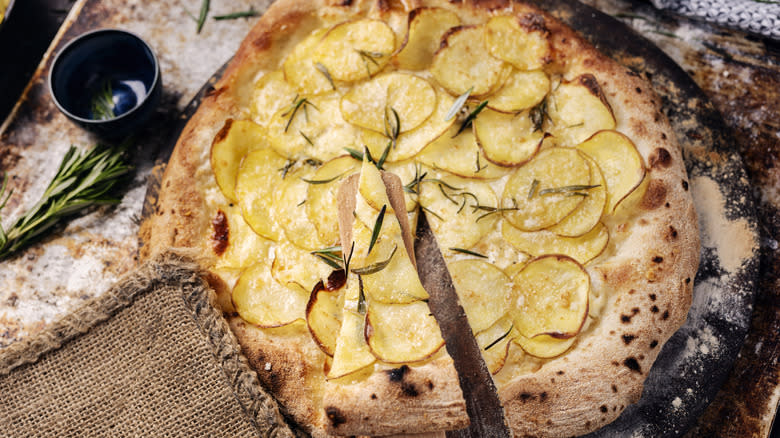
In Italy, less is more when it comes to one of its most world-renowned foods: pizza. A thin wood-fired crust, a fine layer of sauce — whether it be red, white, or pesto — a few dollops of mozzarella cheese, and maybe one or two classic veggies or cured meats are all you need to create an authentic masterpiece.
One pizza from the country deviates from this time-honored formula. The Italian potato pizza was first created in none other than Naples around the 20th century. During this time, many locals were members of the working class and rallied around foods that were affordable, accessible, and filling — like potatoes and pizza dough, made up of only yeast, flour, water, and salt. As time has passed, this dish, originally designed for pure sustenance, has turned into something of an Italian specialty.
Similar to your standard Neapolitan pie, the potato pizza starts with an airy and crisp crust. But sauce and cheese won't be found layered on top. Instead, razor-thin potato slices sit atop the dough, as well as a generous drizzle of oil and fresh herbs like rosemary. And, there you have it — buon appetito!
Of course, endless variations of the delicacy can now be found in recipe books across the globe. In her own version, Italian-American chef Giada De Laurentiis's potato pizza cranks the pizza up a notch with the inclusion of shallots, Leccino olives, a sprinkling of Parmesan Reggiano cheese, and red pepper flakes for a dash of spice.
Frico
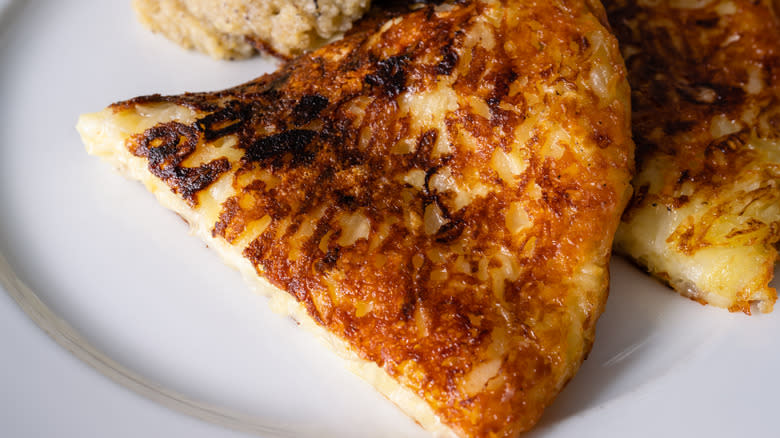
The combination of both cheese and potatoes is truly unmatched. It should come as no surprise that Italy has a dish that marries the two in a no-fuss manner, creating pure comfort food bliss. The dish in question is known as frico, and more specifically, soft frico or frico orbido.
There is an alternative version of the snack called thin frico, or frico friabile, which eliminates the potatoes altogether and consists of just thin cheese fried up to a crisp on a pan. Despite their differences, though, both varieties were born out of the northeastern Friuli region of Italy, and are both prime examples of scrappy cooking as they were originally made from leftover cheese rinds.
Soft frico more closely resembles an extra cheesy potato pancake. To make it, onions and potatoes — either grated or sliced — are added to a pan with oil until well-cooked. Then, Montasio cheese is folded in, and everything is evenly cooked on each side until browned and crunchy. It's typically served immediately when it's still warm and creamy and can be enjoyed as a midday refreshment or even as an appetizer.
Taròz
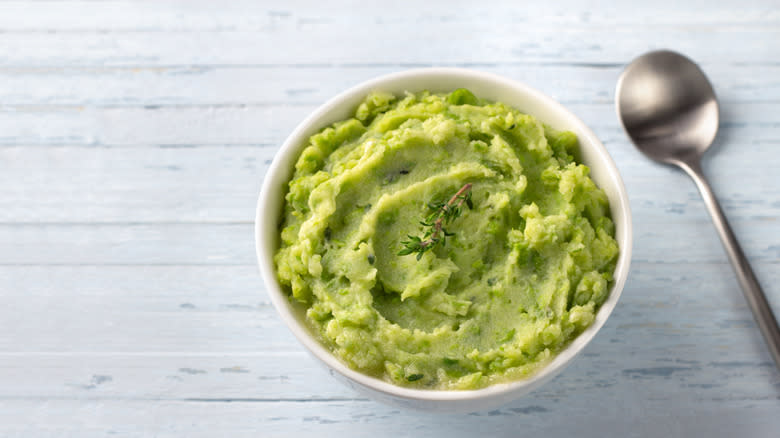
Taroz, or tarrozi, is essentially a rendition of mashed potatoes with a twist. It comes from the Lombardy region of Italy, nestled among the Alps and close to the Swiss border, and fittingly, it makes for the perfect warm and comforting mountainside dish.
The bare bones of taroz are made up of boiled potatoes and green beans, which are combined and mashed together to form one cohesive substance. More flavor is derived from browned onion, generous portions of butter, salt and pepper, and cubes of cheese — preferably Valtellina Casera PDO. This hard cheese is native to the Lombardy area and made with semi-skimmed cow's milk to form a sweeter flavor profile.
Taroz can be enjoyed by itself or accompanied by cured meats such as salami or prosciutto. Some recipes also call for pancetta to be thrown right into the mixture after being cooked with the onions for a little bit of added protein and diversity.
Minestrone
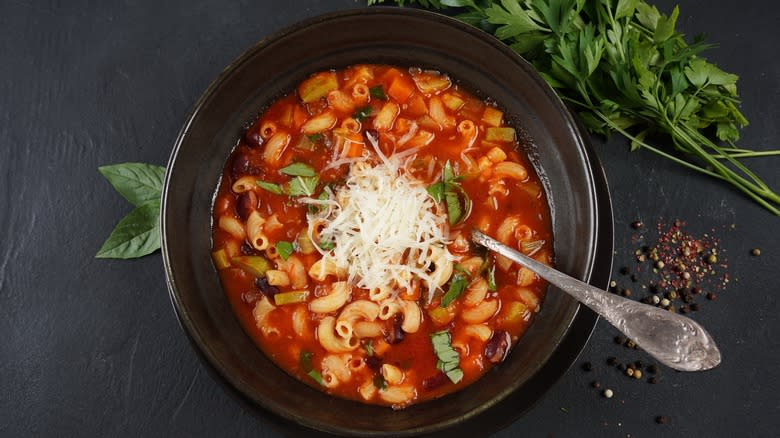
If you're one of those people who believes soup should be eaten like a meal, then minestrone should be a staple in your household. The thick, Italian-style soup has a base of tomato-like broth and either pasta or rice. Then, it is chock full of beans, fresh vegetables, and herbs, and sometimes meat like ground beef or sausage–but many times, it is kept vegetarian.
Minestrone is additionally one of those soups that don't have to be reserved just for the colder months. Its versatility allows it to adapt to whatever vegetables are currently in season, and the only caveat is to choose veggies that won't break down and lose their shape once submerged in the broth bath. But, for the most part, anything goes, and creative liberties can be taken.For example, in an interview with Condé Nast Traveller, Chef Massimo Bottura said he likes to make "Minestrone di tutto," or minestrone of everything, which includes any and all vegetable scraps found in his fridge as well as water, olive oil, and a Parmigiano Reggiano rind.
A couple of the most common minestrone add-ins for at-home chefs and cooks alike are green beans, celery, carrots, spinach, and potatoes. The great thing about the latter is that they are easily obtained year-round. Plus, they add body and texture to your fresh pot of minestrone.
Read the original article on Tasting Table.

